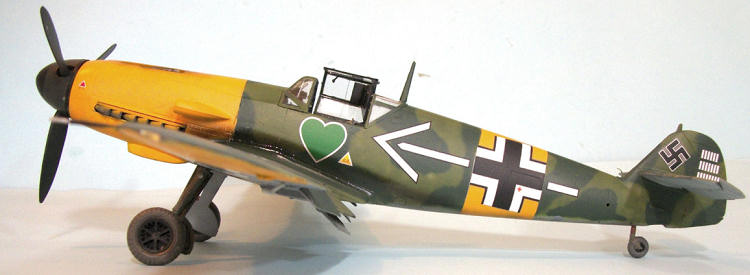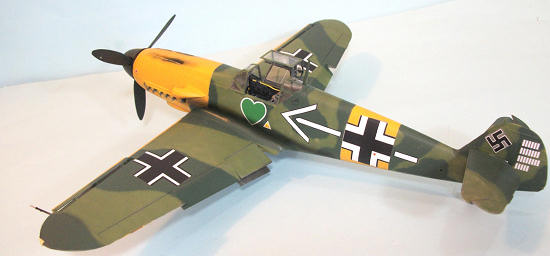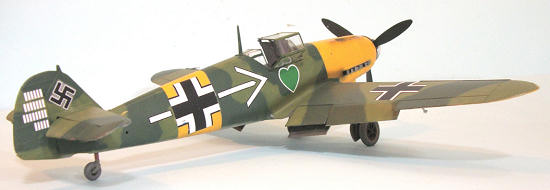Hasegawa 1/32 Bf-109F-2
|
KIT #: |
|
|
PRICE: |
$60.00 SRP |
|
DECALS: |
|
|
REVIEWER: |
Tom Cleaver |
|
NOTES: |
Eagle
Editions Decals used |

Hannes Trautloft and JG 54:
Born
March 3, 1912,
Johannes "Hannes" Trautloft was among the pilots given special fighter training
before the Luftwaffe was revealed.
He started flight training in April 1931 at the
Deutsche Verkehrfliegerschule (German
Air
Transport
School)
at Schleißheim with 29 other trainees in Kameradschaft 31, abbreviated "K
31," a course that included Wolfgang Falck and Günther Lützow. Graduating with
his wings in February 1932, he and nine others were recommended for “special
training” at the secret fighter pilot school in
Lipetsk,
USSR.
Upon completion, he was promoted to Leutnant and became one of the
original members of the Luftwaffe when its existence was revealed in 1935.
 Trautloft was one of the six original Luftwaffe pilots sent to
Spain
in August 1936 with six Heinkel He-51 fighters to train pilots for Franco’s
Nationalist Air Force. Taking up
combat duties while the Spaniards continued to train, Trautloft shot down a
Republican Breguet-19 on
August 25, 1936,
as the first aerial victory for a German pilot since 1918.
On August 30 he shot down a Potez-54, and was in turn shot down himself,
crash-landing and making his way back to Nationalist lines; thus he was also the
first German pilot to be shot down in combat since 1918.
Trautloft was one of the six original Luftwaffe pilots sent to
Spain
in August 1936 with six Heinkel He-51 fighters to train pilots for Franco’s
Nationalist Air Force. Taking up
combat duties while the Spaniards continued to train, Trautloft shot down a
Republican Breguet-19 on
August 25, 1936,
as the first aerial victory for a German pilot since 1918.
On August 30 he shot down a Potez-54, and was in turn shot down himself,
crash-landing and making his way back to Nationalist lines; thus he was also the
first German pilot to be shot down in combat since 1918.
When the He-51 proved itself no match for the Soviet I-15 and I-16
fighters, three prototype Bf-109As were sent to
Spain,
and Trautloft converted to the new fighter, scoring three more victories in
Spain.
He adopted the Green Heart symbol of his native
Thuringia
as his personal insignia at this time.
Returning to
Germany,
he held various squadron leader commands.
On
September 1, 1939,
he was Staffelkapitän of 2./JG 77, which he led through the Polish
campaign, scoring one victory. He
was promoted to Hauptmann and appointed Gruppenkommandeur of I./JG
20 on September 19. He led the unit
during the
Battle
of
France
in Mauy and June, 1940. The unit
became II/JG 51 on July 1 and he led it in the
Battle
of
Britain
in August where he scored two more victories.
On August 25, he was one of several young Gruppenkommandeur jumped
up to Geschwaderkommodore, taking command of JG 54, which he led through
the rest of the battle, during which he scored three more victories for a total
of 13.
JG 54 was transferred to the Balkans in March 1941 and took part in the
Balkans Campaign. They were
assigned to the Northern Group on the Eastern Front for Operation Barbarossa.
By
June 27, 1941,
Trautloft was awarded the Knight’s Cross for 20 victories and outstanding
leadership of the Geschwader. JG 54
would be stationed on the
Leningrad
Front for the next two
 years.
In December 1941 he ordered the Green Heart of
Thuringia
to become the fficial Geschwader symbol and JG 54 became known thereafter as the
Grünherz‑Geschwader.
Trautloft was a popular leader during this period, and by July 1943 his score
was 58.
years.
In December 1941 he ordered the Green Heart of
Thuringia
to become the fficial Geschwader symbol and JG 54 became known thereafter as the
Grünherz‑Geschwader.
Trautloft was a popular leader during this period, and by July 1943 his score
was 58.
On
July 6, 1943,
Trautloft was promoted by General der Jagdflieger Adolf Galland to become
Jagdflieger Inspizient Ost, which put him in overall charge of all
Jagdgeschwadern on the Eastern Front. In November 1943 he was promoted to
Inspekteur der Tagjäger, responsible for all German day fighter units during
the coming “Battle
of
Germany”
in 1944.
In January 1945 Trautloft joined Galland and other high‑ranking pilots in
the "Fighter Pilots Revolt", protesting the squandering of Luftwaffe
fighters and pilots in high‑loss operations like Case Bodenplatte.
Following this, Trautloft was relieved as Inspekteur der Tagjäger and
sent to command 4 Flieger‑Schule Division (4th
Pilot
School
Division) in Strasburg, where he spent the remainder of the war.
Trautloft joined the new Bundesluftwaffe in 1955 and served until
1970, retiring as a Generalleutnant.
He died in 1995.
During its time on the northern front, JG 54 made major experiments with
more effective aircraft camouflage than the standard 74/75/76 which was not
suited for combat over the vast forests of northern Russia, with the result that
the Bf-109s and Fw-190s used by the unit were more distinctively painted than
any other Luftwaffe fighters.
This began in the fall of 1941 as the unit took up permanent positions
and came into possession of large stocks of V-VS paint, which was used for their
experimental schemes.
 Hasegawa finally released the long-awaited Bf-109F in 2010, as a
Bf-109F-4. In 2011, a limited-isssue
kit of Adaolf Galland’s two specially-armed Bf-109F-6U fighters was released,
which had all the parts necessary to make the earlier Bf-109F-2, including the
narrow-chord propeller blades and shallow oil cooler, as well as the slightly
different supercharger intake.
Hasegawa finally released the long-awaited Bf-109F in 2010, as a
Bf-109F-4. In 2011, a limited-isssue
kit of Adaolf Galland’s two specially-armed Bf-109F-6U fighters was released,
which had all the parts necessary to make the earlier Bf-109F-2, including the
narrow-chord propeller blades and shallow oil cooler, as well as the slightly
different supercharger intake.
Since the release of the Bf-109F series, there have been several
aftermarket decal sheets released for this popular model.
I recently picked up the Eagle Editions sheet EC-137 “Bf-109F-2", which
included markings for Trautloft’s well-known Bf-109F-2 painted in two shades of
green.
This is essentially a decal review more than a kit construction review.
I already had a Bf-109F-2 I had done from the Bf-109F-6U kit, which I was
not entirely happy with as far as the markings were concerned, when I picked up
this sheet at Sprue Brothers. Since
the JG 54 airplanes were painted in the field, this meant their new camouflage
went on over the old, which was what I decided to do.
I masked off the national insignia, and proceeded to
 paint the
model in accordance with the colors and patterns shown on the decal
instructions. The airplane was most
likely painted with V-VS paints, since Jerry Crandall goes out of his way in the
instructions to say that the two greens were “non-standard.”
I mixed the two colors with Tamiya paints, matching them to the colors on
the instruction sheet.
paint the
model in accordance with the colors and patterns shown on the decal
instructions. The airplane was most
likely painted with V-VS paints, since Jerry Crandall goes out of his way in the
instructions to say that the two greens were “non-standard.”
I mixed the two colors with Tamiya paints, matching them to the colors on
the instruction sheet.
I first painted the yellow areas, then masked them off, then freehanded
the camouflage, doing a bit of “post shading” with each. Th4e rudder “score” is
shown as 26, so I figured this would have been around the time the airplanes
were first repainted, so I did not do a lot of weathering to the scheme.
I gave the model a coat of
Xtracrylix Clear Gloss and was ready for the decals.
As is usual with Eagle Editions decals, these went on without a problem.
When they were fully set, I gave the model a coat of Xtracrylix Clear
Flat.
I applied exhaust and gunfire stains with Tamiya “Smoke.”
 I think one of the reasons Luftwaffe fighters are so popular with
modelers is because of the plethora of camouflage schemes and markings they can
be done in. Trautloft’s scheme is
far more colorful than the scheme it replaced, and the model now looks very
distinctive lined up with the other excellent Hasegawa 109s.
The Bf-109F kit was re-engineerd by Hasegawa and corrected several small
items from the previous kits, making a good kit even better.
I think one of the reasons Luftwaffe fighters are so popular with
modelers is because of the plethora of camouflage schemes and markings they can
be done in. Trautloft’s scheme is
far more colorful than the scheme it replaced, and the model now looks very
distinctive lined up with the other excellent Hasegawa 109s.
The Bf-109F kit was re-engineerd by Hasegawa and corrected several small
items from the previous kits, making a good kit even better.
Tom Cleaver
August 2012
Decals courtesy of my
wallet.
If you would like your product reviewed fairly and fairly quickly, please contact the editor or see other details in the
Note to
Contributors.
Back to the Main Page
Back to the Review
Index Page


 Trautloft was one of the six original Luftwaffe pilots sent to
Trautloft was one of the six original Luftwaffe pilots sent to
 years.
In December 1941 he ordered the Green Heart of
years.
In December 1941 he ordered the Green Heart of  Hasegawa finally released the long-awaited Bf-109F in 2010, as a
Bf-109F-4. In 2011, a limited-isssue
kit of Adaolf Galland’s two specially-armed Bf-109F-6U fighters was released,
which had all the parts necessary to make the earlier Bf-109F-2, including the
narrow-chord propeller blades and shallow oil cooler, as well as the slightly
different supercharger intake.
Hasegawa finally released the long-awaited Bf-109F in 2010, as a
Bf-109F-4. In 2011, a limited-isssue
kit of Adaolf Galland’s two specially-armed Bf-109F-6U fighters was released,
which had all the parts necessary to make the earlier Bf-109F-2, including the
narrow-chord propeller blades and shallow oil cooler, as well as the slightly
different supercharger intake.  paint the
model in accordance with the colors and patterns shown on the decal
instructions. The airplane was most
likely painted with V-VS paints, since Jerry Crandall goes out of his way in the
instructions to say that the two greens were “non-standard.”
I mixed the two colors with Tamiya paints, matching them to the colors on
the instruction sheet.
paint the
model in accordance with the colors and patterns shown on the decal
instructions. The airplane was most
likely painted with V-VS paints, since Jerry Crandall goes out of his way in the
instructions to say that the two greens were “non-standard.”
I mixed the two colors with Tamiya paints, matching them to the colors on
the instruction sheet. I think one of the reasons Luftwaffe fighters are so popular with
modelers is because of the plethora of camouflage schemes and markings they can
be done in. Trautloft’s scheme is
far more colorful than the scheme it replaced, and the model now looks very
distinctive lined up with the other excellent Hasegawa 109s.
The Bf-109F kit was re-engineerd by Hasegawa and corrected several small
items from the previous kits, making a good kit even better.
I think one of the reasons Luftwaffe fighters are so popular with
modelers is because of the plethora of camouflage schemes and markings they can
be done in. Trautloft’s scheme is
far more colorful than the scheme it replaced, and the model now looks very
distinctive lined up with the other excellent Hasegawa 109s.
The Bf-109F kit was re-engineerd by Hasegawa and corrected several small
items from the previous kits, making a good kit even better.